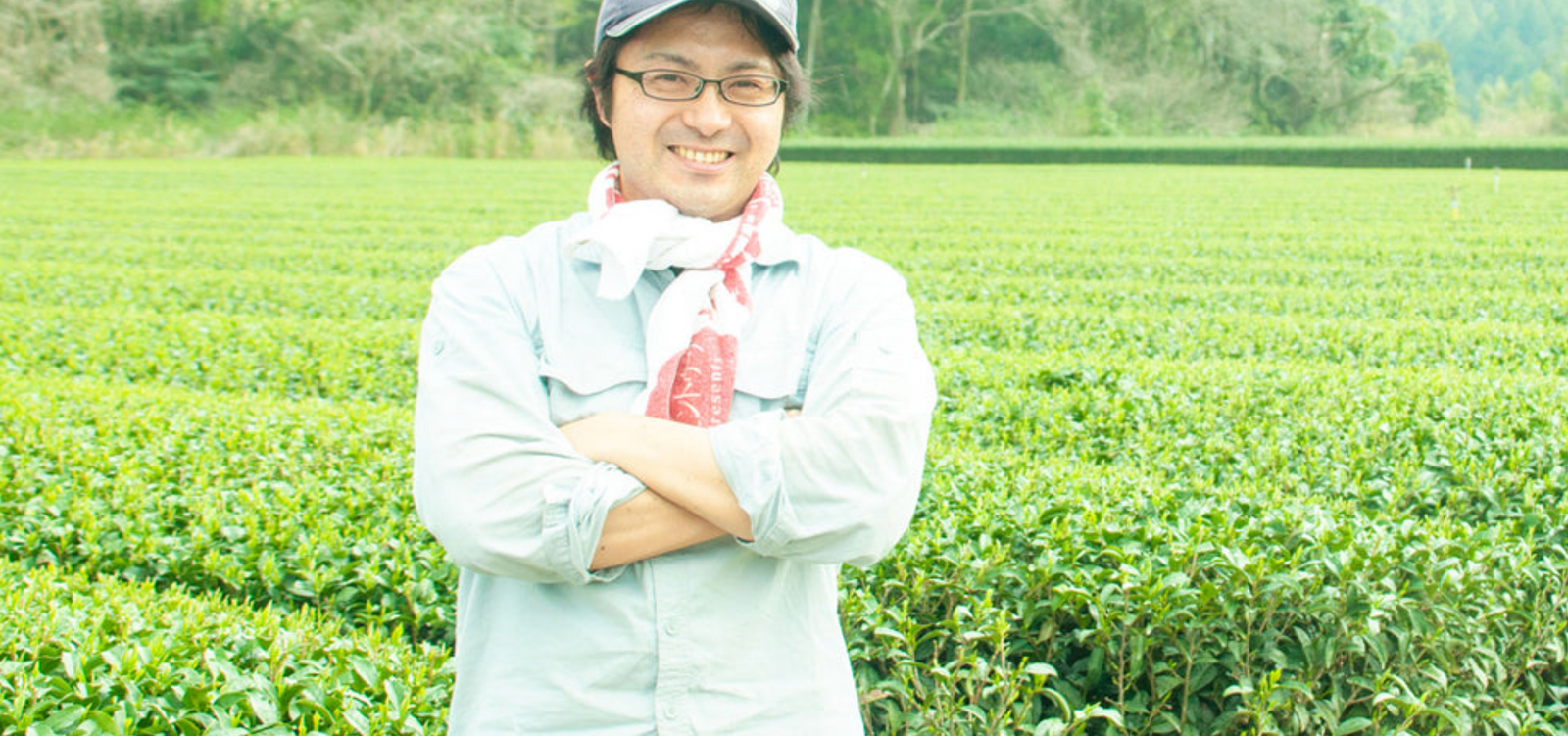今日のYunomi茶農家インタビューは、鹿児島県曽於市にある末吉茶房の3代目であり代表の又木建文さんです。又木さんは、お茶はただ喉の渇きを癒す飲み物ではなく、心を解きほぐし、人と人との繋がりを深めるものであるという考えを強く持っています。末吉茶房の茶農家の皆さんは、この理念のもと、丹精込めて丁寧に育てたお茶を、より多くの人に届けたいと考えています。そして、お茶だけでなく、暮らしに寄り添う、豊かな暮らしを提案していきたいと考えています。
2020年にYunomiで紹介記事を執筆させていただく機会をいただき、偶然にも又木さんのお茶に出会いました。それ以来、繊細で美味しいかぶせ茶を愛飲させていただいています。そして、インタビューでは又木さんからは一切触れられなかった、数々の高い評価を得ているお茶。初めてお会いしてから少し時間が経ちましたが、2023年2月上旬にようやく又木さんにインタビューすることができました。「お茶を飲むと心がほぐれる」とおっしゃっていた通り、お話をさせていただいた方の優しさと寛大さに感動し、リラックスしてお話することができました。これから、また木さんと末吉茶房について、そして末吉茶房の魅力をもっと知っていただけたら嬉しいです。

Moé:まずは、茶農家になるまでの道のりについてお伺いしたいと思います。あなたとご家族はどのようにしてお茶の世界に入ったのですか?
又木さん:私の家では、祖父がお茶作りを始めたのがきっかけです。祖父の知り合いが曽於市でお茶を作っていたのですが、その人がお茶作りをやめようとしていたんです。ところが祖父が「自分が継ごう」と言い出し、その家の茶畑を買ったのが、我が家のお茶作りの始まりでした。その後、2代目の父が茶畑を拡張し、より良いお茶を、より多くのお茶を作れるようにと製茶工場の機械も新しくしました。こうして祖父の代からお茶作りは続いていますが、私が正式に茶農家になったのは比較的最近のことで、2017年です。父と共にお茶作りをしてきました。もうすぐお茶作りを始めてから6年目になります。私自身、幼い頃から父がお茶を作る姿を見て、自分も茶農家になりたいと思っていました。ただ、いつから始めたいのかははっきりとは決めていませんでした。お茶や農業以外の世界を見てみたいという思いが、まずはありました。私は会計士としてキャリアをスタートしました。公認会計士(CPA)の資格も持っています。しかし、30歳になった頃、人生と将来について改めて考える時期になりました。その時、父が「お茶作りは年に一度だけだ」と言っていたのを思い出しました。そして、人は一生のうちに100杯もお茶を作ることはできない、と思いました。そして30歳になった時、まさにその時が来たと感じました。蘇州市に戻り、茶園経営を始めたのです。それが私のスタートです。
萌え: 茶農家になるまでの経緯をどのようにお考えですか?自然な流れだったのでしょうか?
又木さん:そうですね、気持ち的にはごく自然な流れだったと思います。幼い頃から茶農家になるという夢を持っていたので。ですから、会計士から茶農家への移行はスムーズでした。ただ、体力面での苦労はありました。長時間のデスクワーク(つまり、座りっぱなしの生活)から茶畑で働くようになったのです。肉体労働に慣れるのには、明らかに時間がかかりました!また、経済面でも、会計士はどんな仕事でも、決まった時間に定額の給料をもらえます(つまり、典型的なサラリーマンです)。茶農家はそうではありません。経済的な負担や生活の違いを痛感しました。
萌え: 最近、若い世代は急須でお茶を飲まない、いわゆる「ペットボトル世代」だと言われることがよくあります。茶農家のご家庭でいらっしゃるあなたにとって、この現象はご家族に、あるいは茶農家コミュニティ全体にどのような影響を与えていますか?あるいは、与えていませんか?経済的な面でも、その他の面でも。
マタキさん:つまり、今はほとんどの人がペットボトルでお茶を飲むので、お茶農家は今困っているのかとお尋ねですか?
もえ:はい、以上です。長々と質問してしまい、申し訳ありません!
又木さん:ええ、本当にその通りです。末吉茶業でもそれを実感しています。祖父の時代から比べると、状況は厳しくなってきています。周りを見渡すと、多くの茶農家さんが辞めていくのを目にします。私が茶農家を6年間続けてきた中で、本当に美味しいお茶を作っていた農家さんが、経済的、資金的な理由でお茶を辞めていくのを見てきました。彼らも本当に美味しいお茶を作っていた農家さんだったとお伝えします。それでも、彼らがお茶作りをやめてしまうのは、人々が急須でお茶を飲まなくなったという厳しい現実が影響していると思います。
萌え: あなたの故郷である曽於市についてもう少し詳しくお伺いしたいのですが、私自身は鹿児島県に詳しいわけではありません。もちろん、鹿児島が日本有数の茶産地であることは知っていますが。曽於市にはたくさんの茶農家がいるとお考えですか?
又木さん:実はこの地域には昔からお茶農家があまり多くないんです。そもそも曽於市は規模が小さいんです。でも、鹿児島県全体のお茶の生産量の中で、曽於市のお茶が一番遅いというのも理由の一つなんです。曽於市のお茶のシーズンは遅いんです。南部に位置しているにもかかわらず、曽於市は平均気温が低いので、静岡県よりも遅いこともあるんですよ!とはいえ、お茶の収穫時期は遅いんです。これは日本の文化の一つなんですが、人々は「一番茶」をとても大切にしています。一番茶、一番茶。縁起が良いとされているんです。だから、一番茶は高値で取引されることが多いんです。曽於市のように収穫時期が遅いと、一番茶を欲しがっていた人たちが、もうお茶を買い終えてしまっていることが多いんです。そういう意味では、曽於市の茶農家が鹿児島県内の他の茶産地と競争するのは難しく、この地域に茶生産者が少ない理由の一つとなっています。
萌え: なるほど…でも、このような厳しい状況でもお茶作りを続けていらっしゃるんですね。本当に尊敬します!
又木さん:ありがとうございます。実は、曽於市とその周辺の渓谷を含む地域があるんです。江戸時代にはここでお茶が作られ、江戸幕府に送られていたという記録が残っています。ここは都城盆地と呼ばれていて、お茶の歴史が深く刻まれている地域です。ですから、お茶の栽培に非常に適した地域だと思っています。
萌え: なるほど…曽於市で、末吉さんのお茶を待つ価値があるんですね!?ところで、お話に関連してなんですが、末吉茶房の強みや特徴って何だと思いますか?
又木さん:はい。私たちのいる曽於市はお茶の栽培に適した環境です。気候も京都によく似ていると言われています。
萌え:あ、京都?
又木さん:はい、京都です。宇治みたいに…
もえ:実は今京都にいるのでびっくりしました(笑)。
又木さん:(笑)なるほど。そうですね。京都は朝晩がとても冷え込むことで知られています。でも、日中は気温が上がります。だから霧が発生しやすいんです。霧は良いお茶を育てるのに貴重な条件なんです。曽於市を含む都城盆地は京都と気候が似ていると言われています。曽於市はお茶の栽培に適した土壌を持っているので、お茶作りがここで始まったんです。もう一つの強みは、京都の茶農家さんがどうやってやっているのかよく分かりませんが、末吉茶業では、お茶の栽培から収穫、もちろん荒茶作り、そして加工、仕上げまで全て自分たちで行っています。これは近年では珍しいことだと思います。例えば関東では、多くの茶農家さんがお茶の加工に製茶工場を利用していると思います。
萌:なるほど。 和束(京都府の有名な茶産地)でも、農家さんがお茶を摘んで、その茶葉を袋ごと共同加工場に持ち込んでいる様子を見かけました。最近はそういう共同加工場が増えているそうですね。では、末吉茶工房では、お茶の栽培から加工まで、すべて自分たちで行っているんですね?
又木さん:そうです。祖父の代からずっと、自社工場で茶葉の加工をしています。そして何より、お客様の声を常に大切にしてきました。お客様の声こそが何よりも大切です。それが私たちの強みだと信じています。
末吉茶房のキッチンカー
Moé:私も普段から日本茶を愛飲しているので、お茶を飲んでくれる人のことを本当に大切にされていると感じています。そうそう、そういえば、ウェブサイトやSNSでキッチンカーの写真を見ていて気になったんです。キッチンカーの存在について、もう少し詳しく教えていただけますか?どのように使われているんですか?
又木さん:キッチンカーはイベント参加時や、地元の駅でお店を開いたり、雑貨屋さんを回って隣町に行ったりする時などに活用しています。もともとキッチンカーを始めたのは、急須でお茶を淹れることの認知度を高めたいという思いがあったからです。最近は急須でお茶を淹れる人が減ってきている中で、まずは急須でお茶を淹れることに興味を持ってもらいたいと考えました。ペットボトルでお茶を飲んでいる人は、急須でお茶を飲むかペットボトルでお茶を飲むかという選択をしていないように感じます。ペットボトルが当たり前のように身近にあったので、そういう選択肢があることを知らない人がほとんどだと思います。だから、急須でお茶を飲むという選択肢を知らないんだなと感じました。でも、例えばインスタグラムなどで急須でお茶を淹れることをどれだけPRしても、日本茶の飲み方そのものを変えることはできないと思うんです。そういう人たちに、別の選択肢があることを知ってほしい。だったら、自分が直接会いに行って、急須でお茶を淹れてあげよう!って考えたんです。それでキッチンカーを出したんです。


季節ごとに登場する又滝さんのキッチンカー。地元新聞にも取り上げられたことがあるほどです。もし見かけたら、ぜひ又滝さんの心温まるお茶を味わってみてくださいね!
もえ:なるほど、ではキッチンカーで提供しているお茶は、ちゃんと急須で淹れてるんですか?
又木さん:はい、そうですね。急須でお茶を出すと、たいてい驚かれます…。
もえ:素敵なアイデアだと思います。Yunomiで何人かのお茶農家さんにインタビューさせていただいたり、ウェブサイトでもお茶農家さんの紹介記事を書いたりしたことがあるんですが、私が知る限りキッチンカーを持っているお茶農家さんはあなただけなんです。とはいえ、キッチンカーにはすごく惹かれました(笑)。
又木さん:ありがとうございます。
地域資源の活用とおいしいかぶせ茶の秘密
Moé:少し話は変わりますが、あなたの茶園では茶草場農法を実践されているんですよね?もう少し詳しく教えていただけると嬉しいです。他に何か栽培方法があれば教えていただけると嬉しいです。
又木さん:もちろんです。厳密に言えば「茶草場製法」と呼べるかどうかは分かりませんが、カヤやススキ、そして落ち葉などを活用しています。これらの草を栽培し、収穫して茶畑の間に敷き詰めます。稲刈り後には、稲作農家の方から同様の用途で藁をいただくこともあります。これらの資源はゆっくりと土に還り、有機肥料となります。このプロセスは、私たちの茶作りに欠かせないものです。
 茶畑の間に撒かれたススキと落ち葉を捉えたスナップ写真。これらの自然資源はゆっくりと土に還り、有機肥料となっていきます。
茶畑の間に撒かれたススキと落ち葉を捉えたスナップ写真。これらの自然資源はゆっくりと土に還り、有機肥料となっていきます。
もえ:稲作農家さんから藁をもらっているというのは、その方は地元の稲作農家さんなんでしょうか?
マタキさん:はい。通常は曽於市内の稲作農家から資源を調達しています。近隣の市から調達することもあります。ただし、遠方から調達することはありません。
Moé:地元の資源を活用されているとのこと、素晴らしいですね。茶畑の手入れの仕方は、 静岡県で私が尊敬する茶農家の杵塚歩美さんを彷彿とさせます。他に、栽培方法や植え付け方法において、何か特徴的なことはありますか?
又木さん: 被伏栽培(ひふくさいばい)もこの話題に当てはまるでしょうか?もし当てはまるなら、私たちは主にかぶせ茶を遮光栽培しています。遮光期間は、おそらく平均的な期間よりも少し長く、12日から2週間です。周りの他の茶農家さんは一般的に1週間ほど遮光しているので、私たちの場合は遮光期間を倍くらい長く取ることができます。
Moé:ふーん、それがあなたのおいしいお茶の秘密なんでしょうか?
又木さん: [笑い] そうですね…実は、先ほど触れた自社製茶の強み、つまりお客様の声を活かすことにも繋がります。他の多くの茶農家さんと同じように1週間ほど日陰を作ると、日陰茶との収穫量のバランスが取れます。ある意味、win-winの関係ですね。うちの場合は、祖父がお茶作りを始めた頃からお客様からフィードバックをいただいてきましたが、その中で「かぶせ茶を作るには1週間では日陰が足りない」というご意見をいただきました。そこで、かぶせ茶(日陰茶)の特性を際立たせるために、日陰を作る期間を長くすることにしました。ただし、日陰を作ることで茶葉の収穫量は減ることになります。お茶は日光が当たる方がよく育ちますが、日陰を長くすることで逆効果になってしまうからです。つまり、日陰を作る期間が長くなればなるほど、収穫できる茶葉の量は少なくなるのです。それでも、お客様の声を大切にしたいと考えました。それで、私たちは長時間のシェーディングを貫いてきました。
Moé:お茶の収穫量が少なくても、お客様のフィードバックを本当に大切にしていますね!
又木さん:はい。先ほども少し触れましたが、それが私たちの強みだと思います。お客様との接点を持つこと。祖父の知恵ですね。彼は先を見通す先見の明を持っていました。
茶農家又木建文の将来ビジョン
Moé:最後に、今後の展望についてお伺いしたいのですが、お茶の世界において、具体的な理想はありますか?例えば、10年後に理想とするお茶の栽培方法があるとしたら、どのような姿でしょうか?
又木さん:そうですね。ちょっと抽象的なイメージなんですけど、10年後くらいに地元の子供たち、まあ曽於市出身の子じゃなくてもいいんですけど…。でも、最近はYouTuberとか、いろんな職業に憧れる子が多いじゃないですか(笑)。そういう子たちには、お茶農家になりたいって思ってもらいたいですね。子供たちが「お茶農家ってかっこいいな」「素敵だな」って思えるようになったらいいなと思っています。漠然としたイメージですが、子供たちが憧れるようなお茶造りをしていきたいですね。
加えて、具体的に私が目指すビジョンについて触れるとすれば、先ほどお話ししたように、地元の稲作農家から稲わらを仕入れているという点に関係しています。地域資源の循環が続くことは、私にとっても大きな利益です。そこで、私たち茶農家としてどのように貢献できるだろうかと常に自問自答しています。稲作などの肉体労働を手伝ったり、おにぎりによく合うお茶を提供したりといったことが考えられます(笑)。こうした関係性は、必ずしも食事に限る必要はありませんが、作物を育てる過程で互いに助け合うことができると考えています。現状では、茶農家は茶だけを、稲作農家は米だけを栽培しているという状況です。私たちは互いに分断されているように感じます。しかし、地域の中で、米作り、作物作りのプロセスがより密接に繋がっていくことを願っています。
それから、もう一つ!長くなってしまいすみません(笑)。でも、私にとってはこれが一番大事なことかもしれません。お茶は喉の渇きを癒す飲み物であると同時に、それ以上に大切な役割を持っています。リラックスさせたり、ホッとさせたり、そして人と人をつなぐ存在でもあると思っています。そういうお茶の力から、楽しい会話が生まれる…そういう意味で、お茶はただ喉が渇いた時に飲むものじゃないんです。お茶を通して人と人の距離が縮まり、心がほっとする。そんなお茶の持つ特別な価値を、300年後も大切にしていきたいですね。
もえ:おお! 300年って、かなり先の未来ですね。大胆な構想ですね。「茶の間」のことですか?( ※この「茶の間」という概念は、京都府和束町の茶農家・上島さんへのインタビューでも触れられています)。
又木さん:ええ、でももしかしたら曽於市では、地球温暖化の影響で、その頃にはお茶が採れなくなっているかもしれません。でも、この特別なお茶を300年後も守り続けることが私のビジョンです。だから、そのビジョンを念頭に置きながら、お茶作りを続けています。茶農家として、ただ飲むためのものを作っているのではない、ということを常に意識しています。
Moé:そうですね。私もそう思います。個人的には、日本茶を飲むとリラックスできる気がします。もしかしたら、お茶の色(私の場合は朝は緑色が多いです)や、例えば長い一日の終わりに深煎りのほうじ茶を飲んだ時の香りなど、そういうのも関係しているのかもしれませんね。
又木さん:ええ。もちろん、お茶があまり好きじゃない人もいるでしょう(笑)。でも、お茶を飲んで暴力を振るう人はそんなにいないと思います。一般的に、お茶は平和につながる、というか、穏やかな状態を作り出すものだと思っています。
Moé:確かに…でも、たまにコーヒーを飲むのは大好きだけど、その後にアドレナリンが急上昇するのを感じることが多いんです。何かをやり遂げたいという衝動に駆られるような。でも、紅茶を飲むと、たいていもっと穏やかな気持ちになるんです。一日をゆっくりと始められるというか、紅茶に完全に集中している時は、一日を心地よく終わらせてくれるんです。
又木さん:それは嬉しいですね。
Moé:まあ、私はお茶に偏っているかもしれないですね(笑)。ところで、今日のYunomiのインタビューを締めくくるにあたり、何か付け加えたいことや、Yunomiのお客さまに伝えたいメッセージなどはありますか?
又木さん:はい、まずは日本茶に興味を持ってくださり、そして日本茶を飲んでくださったこと、本当にありがとうございます。それが一番嬉しいです。だって、外国の飲み物って、ちょっと勇気がいるじゃないですか…(笑)。だから、まずは日本茶を試してみる第一歩を踏み出してくださって、本当にありがとうございます。本当に感謝しています。そして、これからも皆さんに日本茶を飲んでいただけるよう、全力を尽くします。たとえ私たちが作ったお茶でなくても、日本茶はたくさんあるので、楽しんでいただけると思います。茶農家さんや、産地、様々な要素によって、それぞれに個性があります!ある意味、探求に終わりはないですね!でも、日本茶を通して、この探求を心から楽しんでいただけたら嬉しいです。以上です。ありがとうございました!

ご意見、ご質問、ご感想などございましたら、下記までお気軽にお寄せいただくか、私(Moé Kishida)まで直接ご連絡ください(moe@yunomi.life)。いつでもお待ちしております!
又木建文のお茶を湯飲みで探訪: 末吉茶工房
Instagramアカウントをチェックしてください: sueyoshiseichakobo
写真は鹿児島県曽於市にある末吉茶房によるものです。


